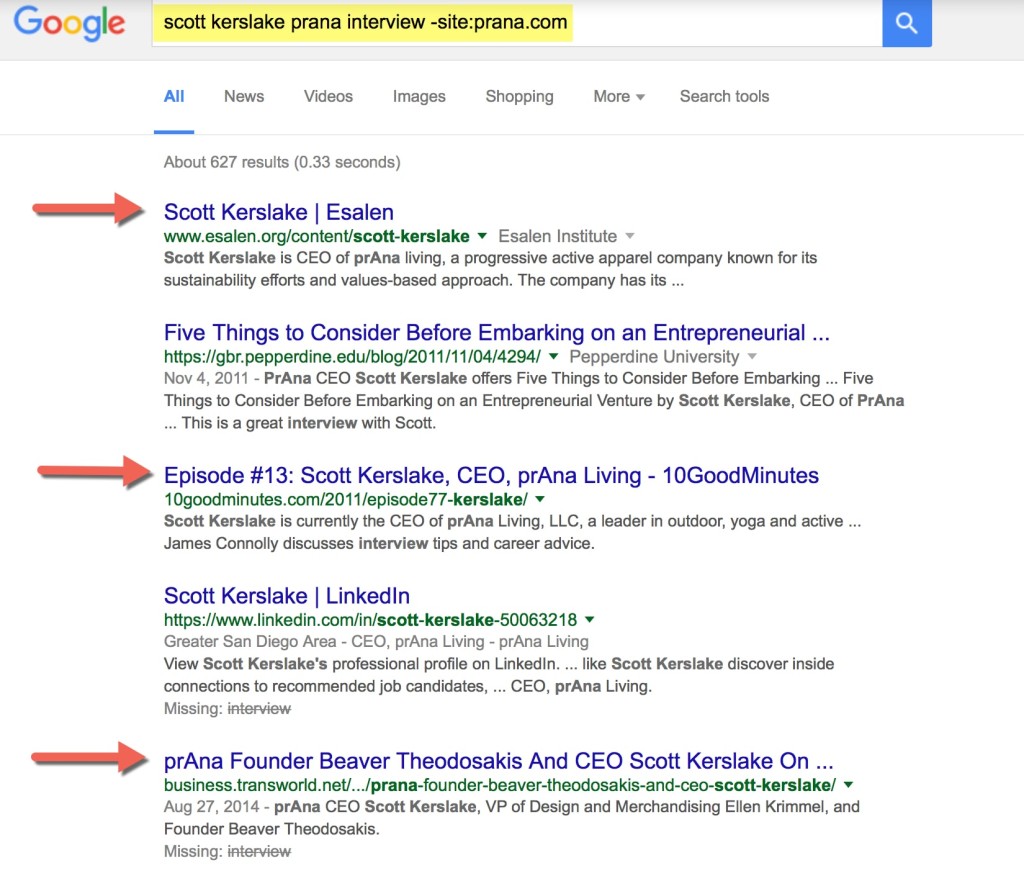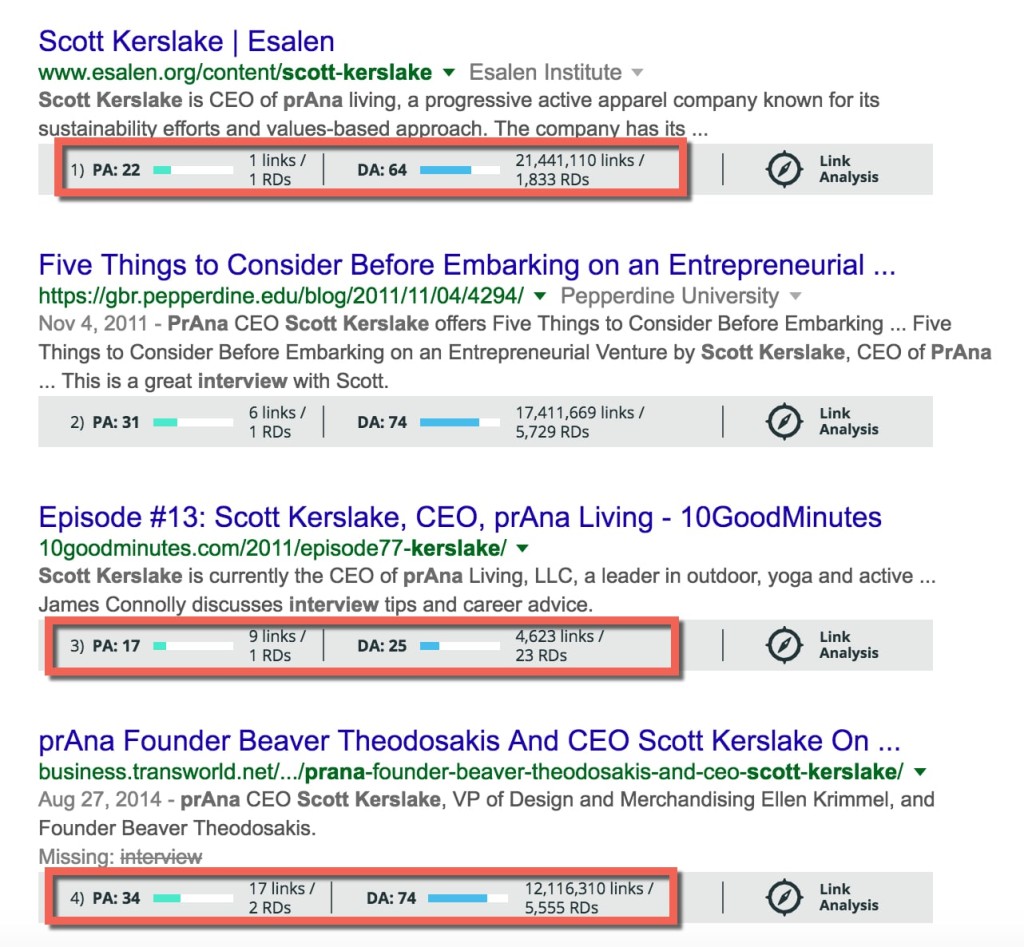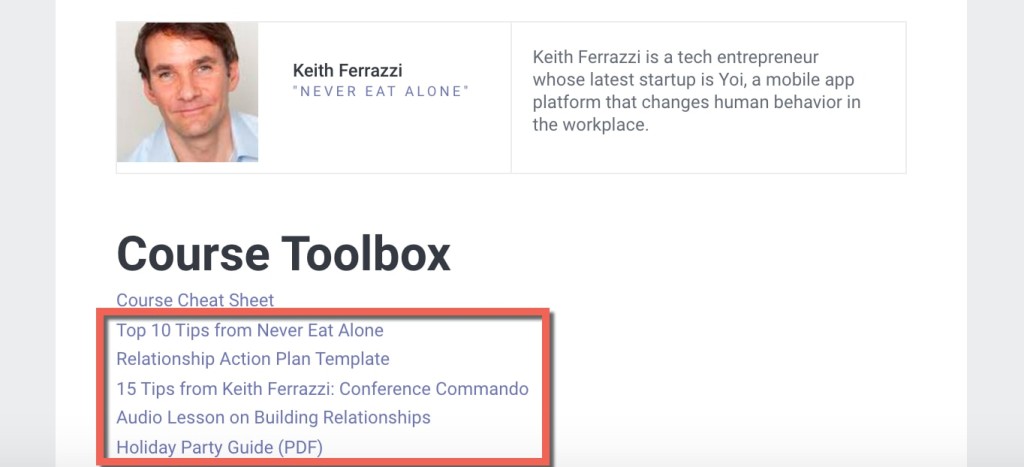In this golden age of thought leadership, interview opportunities provide your clients with increased brand authority, professional credibility, and even domain authority. Getting interviewed on podcasts, news sites, blogs, and in other publications is also a straightforward way to build natural backlinks.—And yet it’s one of the most overlooked and underused natural link building strategies.
Typically, the interviewer will include a short bio of the interviewee on their website with a backlink. This is great, but there is still a lot being left on the table! And sometimes you have to work a little to fully leverage the potential of your client’s online interviews.
In this post, I’ll discuss nine major tactics you can use to fully leverage past, present and future interviews and build more links for your clients.
At a glance, these nine tactics (sorted under past, present, and future interview headings) include:
- Searching for unlinked interviews
- Reaching out to webmasters
- Maximizing further linking opportunities
- Offering additional value
- Helping the interviewer
- Generating more interviews and posts
- Pitching ideas
- Creating linkable assets
- Building buzz beforehand
Building Backlinks to Past Interviews
When we talk about interview link building, i.e. using interviews to gain backlinks, looking for unlinked interviews is the most neglected tactic. If you forgot about this or put it aside, you’ll likely find many high-quality link opportunities.
1. Search for unlinked interviews
- Run a search on a primary spokesperson in your client’s company. The CEO is a good place to start, but you can choose another executive who is involved in sales, marketing, or public relations who might partake in interviews on behalf of the company.
- Google search for past interviews. We will usually look through 50 results or so for each search string we use and record all unlinked opportunities that we find.
Simply type in one of these search string variations:
- [executive’s name] interview [company name] -site:[company domain].com
- [executive’s name] [executive’s position] interview [company name]-site:[company domain].com
The “-site:[company domain].com” portion of the search string is a Google search operator that tells Google to exclude all search results from the company’s website. You could exclude additional sites if you wanted to, such as social media sites. For example, if you wanted to exclude results from Twitter the full search string would be:
- [executive’s name] interview [company name] -site:[company domain].com -site:twitter.com
You can also change the order of the words in the search string before the search operator to potentially find more/different results.
Using one of our clients as an example, prAna, we search for past interviews with their CEO, Scott Kerslake. Lo and behold, we looked at three of the top five search results and found three unlinked interview opportunities from high authority websites!

You’ll need to view each relevant search result to determine if there are indeed any unlinked interview mentions, which can take some time.
Pro tips to speed up your unlinked interview search
- Avoid press release websites. Press releases distributed by newswires such as PRNewswire and PRWeb are automatically syndicated and cannot be edited. It’s almost impossible to get a link from a press release that has already been distributed, so I recommend avoiding them.
- Avoid affiliates. You might find some websites with unlinked interview mentions because they are an affiliate site that never links directly to a company whose products they are promoting. This is because they’d rather have customers buy products through their site rather than buying direct from a brand or manufacturer. You’ll waste your time if you try to get a link from these affiliates.
- Use Ctrl+F (PC) or Cmd+F (Mac). If it takes you more than a couple of seconds to skim the web page and find the specific mention you’re looking for, use Ctrl+F or Cmd+F to bring up the find function on your computer and simply search for the phrase to save time.
- Install MozBar on your browser. By doing so, you can use the SERP Overlay feature and immediately see the Domain Authority and Page Authority of a web page directly from the search results page. You can ignore search results that do not have desirable authority metrics.

The SERP Overlay feature lets you see the web page’s DA and PA at a glance, so you can ignore the page if it doesn’t meet your desired criteria.
(For more tips, check out Kaila Strong’s article on using unlinked brand mentions for link acquisition.)
2. Reach out to webmasters
With your list of unlinked interview mentions, you can reach out to the webmasters, authors, or interviewers and ask them for a link back to your client’s website.
- Start by asking yourself a few questions:
- Who is the author of the article?
- How do we find him/her?
- Is he/she affiliated with the website or just a guest contributor?
The answers to these questions will give you an idea of how easy or difficult it might be to get a link placed, i.e. whether it’s worthwhile to pursue this unlinked mention opportunity.
For example, if you can easily find an author’s name and it looks like he or she owns the site or is a regular contributor, absolutely reach out to the author. It won’t take much of your time and chances are the author can easily go back to the interview and add your client’s link.
In contrast, if the author doesn’t own the site or isn’t a regular contributor, he or she may not be able to go back to the interview and add a link. Instead, the webmaster of the site may need to do this, so you’ll want to contact the webmaster.
Pro tip before starting outreach
- Ask your client to approve your list. Ask for approval to reach out to all of the websites you’ve found. Overall, this is good practice for any back linking strategy or tactic you use. For a number of different reasons, clients might feel uncomfortable with approaching some websites. Avoid upsetting your clients by asking for their approval before moving forward.
Once your client has given the thumbs up on your website list, you can proceed with reaching out to the webmasters involved.
- Be concise when contacting webmasters. Make sure your email is short and to the point. This will increase your outreach success rate.
- Suggest opening a new tab or window. One of the main reasons webmasters or authors may not agree to add a live link is because they don’t want to divert traffic away from their own website. To address this, suggest that they reference your client’s site with a link that opens a new browser tab or window.
- Use a good pitch angle. Okay, you’ve identified the right person to contact and your client has given the green light. So how do you make sure your email is as effectively persuasive as possible? Luckily, because your contact has already mentioned your client’s brand, they’re probably inclined to be helpful and give you the backlink. But you can increase your success rate by using a good pitch angle instead of just emailing them about the unlinked brand mention you found in the interview. For example:
- Improve the user experience. When you reach out, make your pitch about improving their website visitors’ experience (“your website visitors might appreciate a website link in case they want to learn more about the brand”).
- Update outdated or incorrect information. Increase the sense of urgency by informing the author/webmaster/editor of any outdated or inaccurate information, e.g. a misspelled brand name. Your helpful email can then go on to ask them to reference your client’s site to improve the user experience.
I like to use something like this:
Subject: Your Interview With [Interviewee] From [Company Name]
Hi [Author/Editor/Webmaster],
This is Myles Vives, from eREACH. We manage [Company Name’s] online presence.
I really enjoyed your interview with [Interviewee]. You asked great questions that brought out a lot of valuable insights.
I noticed you mention [Company Name] but aren’t mentioning the site. Your [readers/listeners/website visitors] might want to learn more about [Company Name]. Mind sharing the website with them? Perhaps as a link that opens in a new tab or window?
Have a great day and keep up the great work!
Best Regards,
Myles
Pro tips on building relationships with webmasters
- Ask for a connection. If you don’t hear back from the webmaster, reach out to the author and ask them if they can connect you with their contact at the website.
- Think beyond trying to get backlinks just for higher rankings. Develop a relationship with the webmasters, authors, and editors you reach out to. In addition to asking them to reference your client’s site, take the opportunity to provide value. Spend a few minutes finding some areas of their website or marketing that they can optimize to improve performance and share your insights with them.
- You, or your client, can also offer to contribute valuable content to their website, which will lead to more links and exposure in the future.
- Lastly, don’t forget to follow up with your list after a few days. People can get busy and maybe they didn’t have a chance to read or respond to your email. I like to follow up at least three times, but if there is an unlinked mention on a really high authority website, I won’t stop until I get the link or they tell me to stop emailing them!
3. Maximize further link opportunities
In addition to looking for unlinked brand mentions in an interview and asking for a link, here are a few more ways to leverage past interviews.
- Identify peripheral websites that link to the interview. Look at the websites that link to your client’s existing interview. Determine if these websites are authoritative and generate traffic, i.e. they could be good backlink opportunities. If so, you can potentially pitch these websites about contributing a blog post or an interview (that links back to your client’s site) that builds on top of you client’s earlier interview or a topic related to it (that falls within your client’s expertise).
- Use old interviews to land new ones. The more interviews your clients have under their belts, the more social proof and authority they will gain, making it easier to land new interviews that will give them natural backlinks. When you pitch authors, reporters, or webmasters, make sure you’ve compiled a list of all your interviews and include it with your pitch.
- Offer a complementary blog post. Even if it’s been months or years since your client completed an interview, you can reach out to the interviewer about having your client contribute a new blog post to their website with new, improved, and/or additional information. This gives you the opportunity to receive more than one link from the same domain, and potentially point the link to a deeper page–as opposed to only the home page.
Building Backlinks to Present Interviews
Now, let’s discuss today and assume your client has an interview around the corner. Here are some great ways to maximize these backlink opportunities, get further inner page links, and take full advantage of the publicity.
4. Offer additional value
- Ask the interviewer to link to your client’s resources. During the interview, have your client talk about a valuable resource they have on their site that viewers/readers/listeners can access. Then inform your client to ask the interviewer (during the interview to hold them accountable) if it would be okay to have the interviewer share the link with his/her audience on their website, perhaps in the interview’s show notes. We’ve yet to encounter an interviewer who has said “no”. This is a great opportunity to build inner page backlinks from authority websites–not just links to your home page.
Pro tip on promoting resources
- Talk to your client about referencing multiple resources. The more resources your client can share, the more inner-page backlinks they will earn.

Give access to resources on your website–a good deep linking opportunity.
- Offer discounts, promos, or specials. In addition to resources, having your client share any discounts, promotions, or specials during an interview will give them more opportunities to earn natural deep linking.
5. Help the interviewer
- Have your clients tell the interviewer that they are promoting the interview. If your clients contribute to the success of an interview, the interviewer will be more willing to promote them and link to your client’s resources.
- Ask viewers/readers/listeners to share. During your client’s interview, have them help the interviewer by asking viewers/readers/listeners to share the interview with someone who would benefit from it. The more people that share and engage with the interview, the better chance it has of earning backlinks. As a result, more link authority may pass to your client’s website because of the links that exist within the interview page.
- Tell your client to share the interview with their followers. Aside from a boost in referral traffic and social proof, having your client share the interview with their followers through social media, their website, and email can indirectly lead to gaining more link authority (as described in the previous point) and direct backlinks, e.g. someone may blog about the interview and link to the interview and your client’s website.
6. Get more interviews or guest posts
- Set up a follow-up blog post or interview. During the interview, suggest that your client mention he or she can provide more information about the topic with a follow-up blog post or perhaps another interview. This will give your client the opportunity to earn more links and work on deep linking.
- Ask for referrals. Soon after your client is done with their interview, have them ask their interviewers if they know any other authors, reports, bloggers, or webmasters that might be interested in speaking with them. If so, have your client politely ask for an introduction. This can lead to more interviews and potential guest post opportunities, generating more traffic and link diversity.
Pro tip on following up post-interview
- Encourage your client to send a thank-you note or email to the interviewer but never send a gift. This will help your clients stand out among the hundreds of others interviewed and can help build a relationship with the interviewer, which can lead to partnerships, referrals, and more appearances or mentions on their website.
Building Backlink Potential in Future Interviews
When your client has more time before their interview, here are several things you can help them with to maximize their future engagement.
7. Pitch ideas
- Study the interviewer’s platform in advance. Have your clients spend some time listening/reading/watching their interviewer’s material and studying their audience.
- Propose mutually beneficial discussion ideas. Then, have your client propose different discussion ideas that not only align with what the interviewer wants to cover for his/her audience, but also give your client the chance to generate attention to parts of their business and website that will increase revenue and the opportunity to earn links.
8. Create linkable assets
- Tailor a resource or checklist or other asset. Help your clients create linkable assets that will appeal to listeners/readers/watchers. A resource or checklist that can be later referenced usually earns more backlinks. Unlike a general resource that your client may already have, here, your client can create a unique value-add that connects with people on a more personal level.
- Specifically encourage listeners to share this asset. Make sure your client encourages others to share the linkable asset if they find it valuable.
9. Build buzz beforehand
- Promote the upcoming interview on social media. The more people who read, watch, or listen to the interview, the higher the likelihood that someone will link to your client’s mentioned resources and linkable assets.
- Build anticipation with your client’s email list. In addition to social media, email, and website promotion, weeks before the actual interview, your client could begin telling his or her following that he or she will be sharing something special, e.g. something never discussed before. This might pique people’s curiosity and increase the interview’s reach.
Recap of Ways to Leverage Past, Present and Future Interviews for Link Building
Leveraging your client’s interview appearances can be a goldmine of backlinking opportunities. You might be surprised to learn that many SEO agencies who hire us for our white label link building services forget about interview link building! about Here’s a quick recap of the nine tactics I covered:
Past Interviews
- Search for unlinked interviews (Google is your friend here)
- Reach out to webmasters (get your client’s OK, be brief, add value)
- Maximize further link opportunities (peripheral websites, further interviews/blog posts)
Present Interviews
- Offer additional value (promote existing resources, offer discounts/promos/specials)
- Help the interviewer (promote their interview before and after to client’s followers)
- Generate more interviews and posts (during and also after the interview via referrals)
Future Interviews
- Pitch ideas (become familiar with interviewer’s platform)
- Create linkable assets (tailor special-made resources that add value)
- Build buzz beforehand (pique people’s curiosity, build anticipation with new info)
If you have a great tip to add or any questions, I’d love to hear from you in the comments section. Also, if you found value in this post and feel others would too, please feel free to share it!


